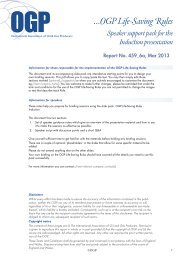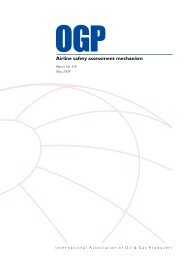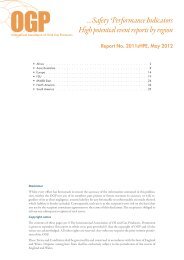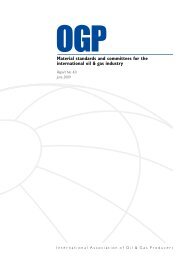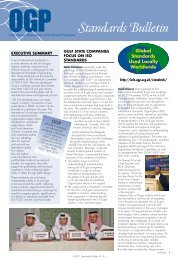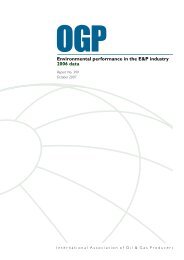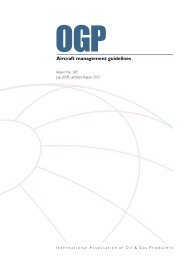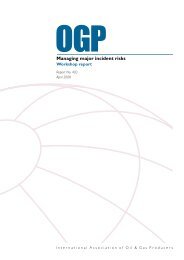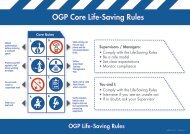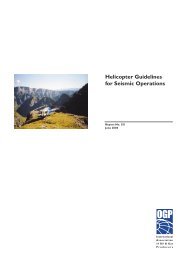Helicopter guidelines for land seismic & helirig operations - OGP
Helicopter guidelines for land seismic & helirig operations - OGP
Helicopter guidelines for land seismic & helirig operations - OGP
You also want an ePaper? Increase the reach of your titles
YUMPU automatically turns print PDFs into web optimized ePapers that Google loves.
<strong>Helicopter</strong> <strong>guidelines</strong> <strong>for</strong> <strong>land</strong> <strong>seismic</strong> & <strong>helirig</strong> <strong>operations</strong><br />
2 Health, safety & environmental management<br />
systems (HSE-MS)<br />
2.1 Introduction<br />
2.1.1 <strong>OGP</strong> (then E&P Forum) adopted HSE-MS as its recommended practice publishing Report<br />
210 Guidelines <strong>for</strong> the development and application of HSE-MS in July 1994. For geophysical<br />
<strong>operations</strong> specifics were developed in <strong>OGP</strong> Report 317, HSE aspects in a contracting environment<br />
<strong>for</strong> geophysical <strong>operations</strong>, Schedules and Plans, May 2001.<br />
In view of the extensive regulation applicable and elaborate safety systems already in place in<br />
aviation, <strong>OGP</strong> did not extend the requirement <strong>for</strong> HSE-MS to aviation matters in its earlier<br />
Report 239, Aircraft Management Guide (AMG) of March 1998. However, the current AMG<br />
(<strong>OGP</strong> Report 390) does require aircraft operators to have safety management systems and safety<br />
cases/safety expositions in place, <strong>for</strong> contracts of a duration of more than one year or involving<br />
more than 50 flying hours per month (ref. <strong>OGP</strong> Report 390 Section 3 and Appendix 4).<br />
The minimum required <strong>for</strong> any operation is a documented risk assessment (as per Appendix 2 of<br />
the AMG) and an “operation specific safety exposition”.<br />
In all, HSE-MS is now being introduced in <strong>OGP</strong> related aviation industry, but is still in an early<br />
development stage. It is not within the remit of this document to elaborate on the subject matter<br />
and the user is referred to the other documents mentioned above, while it is expected that more<br />
will be developed in due time.<br />
2.2 Recommended minimum requirement <strong>for</strong> HSE-MS<br />
2.2.1 As explained above, the introduction of <strong>for</strong>mal HSE-MS in aviation matters is still in a<br />
development stage. The recommended minimum elements to be in place are:<br />
1. Company and <strong>seismic</strong> contractor to have documented systems and plans in place, compliant<br />
with <strong>OGP</strong> report № 317, HSE aspects in a contracting environment <strong>for</strong> geophysical <strong>operations</strong>,<br />
May 2001 (referred to as “<strong>OGP</strong> Report 317” in this document).<br />
2. A Crew HSE plan and a Project HSE Plan (as per <strong>OGP</strong> Report 317) to cover all aspects of<br />
helicopter support to the <strong>operations</strong>, with the exception of specialist aviation matters. In<br />
particular it should contain written and procedures agreed by the three Parties, <strong>for</strong> HSE<br />
critical parts of the <strong>operations</strong> such as:<br />
a. Flight planning and flight authorisation, changes in flight plans.<br />
b. Passenger transport.<br />
c. Cargo transport, loading, external load <strong>operations</strong>.<br />
d. Refueling <strong>operations</strong>.<br />
3. The Project HSE plan can be a document jointly developed and owned by the three Parties.<br />
An alternative is that the Project HSE Plan is owned by the Seismic Contractor and<br />
supplemented by interface documentation, addressing:<br />
a. Gaps, contradictions or differences between the three parties systems, eg:<br />
b. Standards applicable, which one prevails.<br />
c. Any activities where more than one Party has to play a role eg:<br />
i. Flight planning.<br />
ii. Emergency response.<br />
iii. Provision of fuel, PPE, equipment, training etc.<br />
iv. Use of equipment <strong>for</strong> specific tasks, eg carrousels, long line.<br />
v. Documented inspection and maintenance schedules of slings, cargo hooks, nets and<br />
any device involved in lifting of external loads.<br />
d. The recommendations of the acceptance audit of the <strong>Helicopter</strong> Provider carried out by<br />
© <strong>OGP</strong><br />
3



